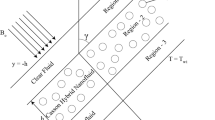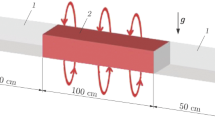Abstract
This article deals with the numerical simulation of the electroosmotic flow of methanol-based aluminum oxide (Al2O3–CH3OH) nanofluid in a tapered microchannel. The shear-thickening attributes of methanol are characterized by the Sisko fluid model. The tapered microchannel walls move with peristaltic wave velocity. Buongiorno model in combination with the Corcione model for thermal conductivity and viscosity is employed to predict the heat transfer characteristics of Al2O3–methanol nanofluid. The Maxwell–Garnett model is employed to compute the effective electric conductivity of nanofluids. The effect of the porous medium in the flow field is signified by modified Darcy’s law. The salient attributes of viscous dissipation and Joule heating caused by electroosmosis are also taken into account. The approximations of the lubrication approach and the Debye–Hückel linearization are invoked in mathematical formulation for considerable simplification of the flow problem. The solutions of the acquired set of nonlinear governing equations are computed numerically through Maple 17. The graphical results for various physical quantities are also presented for physical interpretation and discussion. It is revealed that fluid becomes more viscous for enhancement in the consistency parameter. Furthermore, maintaining a larger temperature difference within microchannel produces a reduction in the concentration of nanoparticles. Temperature and velocity profiles are strongly dependent on the electroosmosis mechanism. The simulated results will be very important for designing biomicrofluidics devices dealing with rheologically complex fluids such as lubricating greases, blood, saliva or mucus.










Similar content being viewed by others
Abbreviations
- d 1 :
-
Half-width of the channel (M)
- m′ :
-
Non-uniformity parameter (–)
- b 1, b 2 :
-
Amplitude of waves (M)
- Λ:
-
Wavelength (M)
- \( \tilde{u},\tilde{v} \) :
-
Velocity components in the axial and transverse direction (ms−2)
- ρ nf :
-
Nanofluid density (kg m−3)
- \( \tilde{t} \) :
-
Time parameter (S)
- ̃\( \tilde{p} \) :
-
Pressure field (Nm−2)
- \( \tilde{S}_{{\tilde{x}\tilde{x}, }} \tilde{S}_{{\tilde{x}\tilde{y}}} , \tilde{S}_{{\tilde{y}\tilde{y}}} \) :
-
Shear stress components (ML−1 T−2)
- \( \rho_{\text{e}} \) :
-
Local electric charge density (cm−3)
- \( E_{{\tilde{x},}} E_{{\tilde{y}}} \) :
-
The axial and transverse electric field (MLA−1 T−3)
- \( c_{\text{nf}} , c_{\text{p}} \) :
-
Specific heat of nanofluid and nanoparticles (J kg−1 K−1)
- \( \tilde{T} \) :
-
Temperature field (K)
- \( D_{\text{B}} \) :
-
Brownian diffusion parameter (m2 s−1)
- \( \tilde{\phi } \) :
-
Concentration field (kg m−3)
- \( \tilde{T}_{0} , \tilde{T}_{1} \) :
-
The temperature at the lower and upper wall (K)
- \( \sigma_{\text{nf}} \) :
-
Electrical conductivity (S m−1)
- \( D_{\text{T}} \) :
-
Thermophoretic parameter (m2 s−1)
- \( n \) :
-
Power-law index (–)
- \( A_{1} \) :
-
Rivlin Erickson tensor (s−1)
- \( d_{\text{p}} , d_{\text{bf}} \) :
-
The diameter of nanoparticles and base fluid molecule (M)
- \( T_{\text{fr}} \) :
-
The freezing temperature of the base fluid (K)
- \( K^{*} \) :
-
Permeability parameter (m2)
- \( \tilde{E} \) :
-
Electric potential (V)
- \( \varepsilon_{0} \) :
-
The permittivity of free space (Fm−1)
- \( \varepsilon \) :
-
The relative permittivity of the solvent (–)
- \( n^{ + } ,n^{ - } \) :
-
Local density of positive and negative ions (cm−3)
- \( e \) :
-
Charge of electron (C)
- z:
-
Valency (–)
- \( p \) :
-
Dimensionless pressure parameter (–)
- \( U \) :
-
Helmholtz–Smoluchowski velocity (–)
- k:
-
The dimensionless Debye length parameter (–)
- \( {\text{Da}} \) :
-
Darcy resistance parameter (–)
- \( \psi \) :
-
Dimensionless stream function (–)
- \( \beta_{s} \) :
-
Dimensionless material parameter (–)
- \( Pr \) :
-
Prandtl number (–)
- \( N_{\text{b}} \) :
-
Dimensionless Brownian diffusion parameter (–)
- \( N_{\text{t}} \) :
-
Dimensionless thermophoretic parameter (–)
- \( Br \) :
-
Brinkmann number (–)
- \( \xi \) :
-
Dimensionless zeta potential (–)
- \( Q \) :
-
Dimensionless time-averaged flow rate (–)
- \( F \) :
-
Dimensionless volumetric flow rate (–)
- \( m \) :
-
Dimensionless non-uniformity parameter (–)
References
Akbar NS (2014) Peristaltic Sisko nanofluid in an asymmetric channel. Appl Nanosci 4:663–673. https://doi.org/10.1007/s13204-013-0205-1
Ali M, Khan WA, Sultan F, Shahzad M (2020) Numerical investigation on thermally radiative time-dependent Sisko nanofluid flow for a curved surface. Phys A 550:124012. https://doi.org/10.1016/j.physa.2019.124012
Berli CLA, Olivares ML (2008) Electrokinetic flow of non-Newtonian fluids in microchannels. J Colloid Interface Sci 320:582–589. https://doi.org/10.1016/j.jcis.2007.12.032
Bhatti MM, Zeeshan A, Ellahi R, Shit GC (2018) Mathematical modeling of heat and mass transfer effects on MHD peristaltic propulsion of two-phase flow through a Darcy–Brinkman–Forchheimer porous medium. Adv Powder Technol 29:1189–1197. https://doi.org/10.1016/j.apt.2018.02.010
Bhatti MM, Riaz A, Zhang L, Sait SM, Ellahi R (2020a) Biologically inspired thermal transport on the rheology of Williamson hydromagnetic nanofluid flow with convection: an entropy analysis. J Therm Anal Calorim. https://doi.org/10.1007/s10973-020-09876-5
Bhatti MM, Marin M, Zeeshan A, Ellahi R, Abdelsalam SI (2020b) Swimming of motile gyrotactic microorganisms and nanoparticles in blood flow through anisotropically tapered arteries. Front Phys 8:95. https://doi.org/10.3389/fphy.2020.00095
Chakraborty S, Roy S (2008) Thermally developing electroosmotic transport of nanofluids in microchannels. Microfluid Nanofluid 4:501–511. https://doi.org/10.1007/s10404-007-0212-1
Hamid KA, Azmi WH, Mamat R, Usri NA (2014) Thermal conductivity enhancement of aluminum oxide nanofluid in ethylene glycol. Appl Mech Mater 660:730–734. https://doi.org/10.1016/j.egypro.2015.11.509
Hamid KA, Azmi WH, Mamat R, Usri NA, Najafi G (2015) Investigation of Al2O3 nanofluid viscosity for different water/EG mixture based. Energy Procedia 79:354–359. https://doi.org/10.1016/j.egypro.2015.11.502
Herr AE, Molho JI, Santiago JG, Mungal MG, Kenny TW, Garguilo MG (2000) Electroosmotic capillary flow with nonuniform zeta potential. Anal Chem 72:1053–1057. https://doi.org/10.1021/ac990489i
Jiang H, Weng X, Chon CH, Wu X, Li D (2011) A microfluidic chip for blood plasma separation using electro-osmotic flow control. J Micromech Microeng 21:085019. https://doi.org/10.1088/0960-1317/21/8/085019
Jiang Y, Qi H, Xu H, Jiang X (2017) Transient electroosmotic slip flow of fractional Oldroyd-B fluids. Microfluid Nanofluid 21:7. https://doi.org/10.1007/s10404-016-1843-x
Kawamata T, Yamada M, Yasuda M, Seki M (2008) Continuous and precise particle separation by electroosmotic flow control in microfluidic devices. Electrophoresis 29:1423–1430. https://doi.org/10.1002/elps.200700658
Kim BJ, Yoon SY, Lee KH, Sung HJ (2009) Development of a microfluidic device for simultaneous mixing and pumping. Exp Fluids 46:85–95. https://doi.org/10.1007/s00348-008-0541-1
Li F-Q, Jian Y-J, Xie Z-Y, Wang L (2017) Electromagnetohydrodynamic flow of Powell–Eyring fluids in a narrow confinement. J Mech 33:225–233. https://doi.org/10.1017/jmech.2016.75
Lin CH, Fu LM, Chien YS (2004) Microfluidic T-form mixer utilizing switching electroosmotic flow. Anal Chem 76:5265–5272. https://doi.org/10.1021/ac0494782
Moradgholi M, Nowee SM, Farzaneh A (2018) Experimental study of using Al2O3/methanol nanofluid in a two-phase closed thermosyphon (TPCT) array as a novel photovoltaic/thermal system. Sol Energy 164:243–250. https://doi.org/10.1016/j.solener.2018.02.055
Mostafizur RM, Aziz ARA, Saidur R, Bhuiyan MHU, Mahbubul IM (2014) Effect of temperature and volume fraction on rheology of methanol-based nanofluids. Int J Heat Mass Transf 77:765–769. https://doi.org/10.1016/j.ijheatmasstransfer.2014.05.055
Nadeem S, Akbar NS (2010) Peristaltic flow of Sisko fluid in a uniform inclined tube. Acta Mech Sin 26:675–683. https://doi.org/10.1007/s10409-010-0356-1
Ng C, Qi C (2014) Electroosmotic flow of a power-law fluid in a non-uniform microchannel. J Non-Newton Fluid 208–209:118–125. https://doi.org/10.1016/j.jnnfm.2014.04.008
Osman S, Sharifpur M, Meyer JP (2019) Experimental investigation of convection heat transfer in the transition flow regime of aluminum oxide-water nanofluids in a rectangular channel. Int J Heat Mass Transf 133:895–902. https://doi.org/10.1016/j.ijheatmasstransfer.2018.12.169
Pang C, Jung J, Kang YT (2013) Thermal conductivity enhancement of Al2O3 nanofluids based on the mixtures of aqueous NaCl solution and CH3OH. Int J Heat Mass Transf 56:94–100. https://doi.org/10.1016/j.ijheatmasstransfer.2012.09.031
Prakash J, Tripathi D (2018) Electroosmotic flow of Williamson ionic nanoliquids in a tapered microfluidic channel in presence of thermal radiation and peristalsis. J Mol Liq 256:352–371. https://doi.org/10.1016/j.molliq.2018.02.043
Prakash J, Ansu AK, Tripathi D (2018) Alterations in peristaltic pumping of Jeffery nanoliquids with electric and magnetic fields. Meccanica 53:3719–3738. https://doi.org/10.1007/s11012-018-0910-7
Prakash J, Jhorar R, Tripathi D, Azese MN (2019) Electroosmotic flow of pseudoplastic nanoliquids via peristaltic pumping. J Braz Soc Mech Sci Eng 41:61. https://doi.org/10.1007/s40430-018-1555-0
Ranjit NK, Tripathi D, Shit GC (2019) Entropy generation and Joule heating of two-layered electroosmotic flow in the peristaltically induced micro-channel. Int J Mech Sci 153–154:430–444. https://doi.org/10.1016/j.ijmecsci.2019.02.022
Ren L, Li D (2001) Electroosmotic flow in heterogeneous microchannels. J Colloid Interface Sci 243:255–261. https://doi.org/10.1006/jcis.2001.7824
Sadek SH, Pinho FT (2019) Electro-osmotic oscillatory flow of viscoelastic fluids in a microchannel. J Nonnewton Fluid Mech 266:46–58. https://doi.org/10.1016/j.jnnfm.2019.01.007
Sarkar S, Ganguly S (2015) Fully developed thermal transport in combined pressure and electroosmotically driven flow of a nanofluid in a microchannel under the effect of a magnetic field. Microfluid Nanofluid 18:623–636. https://doi.org/10.1007/s10404-014-1461-4
Sheikholeslami M (2019) Numerical approach for MHD Al2O3-water nanofluid transportation inside a permeable medium using innovative computer method. Comput Methods Appl Mech Eng 344:306–318. https://doi.org/10.1016/j.cma.2018.09.042
Sheikholeslami M, Gerdroodbary MB, Moradi R, Shafee A, Li Z (2019) Application of neural network for estimation of heat transfer treatment of AlO–HO nanofluid through a channel. Comput Methods Appl Mech Eng 344:1–12. https://doi.org/10.1016/j.cma.2018.09.025
Siddiqui AA, Lakhtakia A (2009) Steady electro-osmotic flow of a micropolar fluid in a microchannel. Proc R Soc A Math Phy Eng Sci 465:501–522. https://doi.org/10.1098/rspa.2008.0354
Sisko AW (1958) The flow of lubricating greases. Ind Eng Chem 50:1789–1792. https://doi.org/10.1021/ie50588a042
Stroock AD, Weck M, Chiu DT, Huck WT, Kenis PJ, Ismagilov RF, Whitesides GM (2000) Patterning electro-osmotic flow with patterned surface charge. Phys Rev Lett 84:3314. https://doi.org/10.1103/PhysRevLett.84.3314
Tan Z, Qi H, Jiang X (2014) Electroosmotic flow of Eyring fluid in slit microchannel with slip boundary condition. Appl Math Mech Engl Ed 35:689–696. https://doi.org/10.1007/s10483-014-1822-6
Tripathi D, Yadav A, Bég OA (2017) Electro-osmotic flow of couple stress fluids in a micro-channel propagated by peristalsis. Eur Phys J Plus 132:173. https://doi.org/10.1140/epjp/i2017-11416-x
Tripathi D, Yadav A, Bég OA, Kumar R (2018a) Study of microvascular non-Newtonian blood flow modulated by electroosmosis. Microvasc Res 117:28–36. https://doi.org/10.1016/j.mvr.2018.01.001
Tripathi D, Sharma A, Bég OA (2018b) Joule heating and buoyancy effects in electro-osmotic peristaltic transport of aqueous nanofluids through a microchannel with complex wave propagation. Adv Powder Technol 29:639–653. https://doi.org/10.1016/j.apt.2017.12.009
Wang X, Jiang Y, Qiao Y, Xu H, Qi H (2020) Numerical study of electroosmotic slip flow of fractional Oldroyd-B fluids at high zeta potentials. Electrophoresis 41:769–777. https://doi.org/10.1002/elps.201900370
Yao B, Luo G, Feng X, Wang W, Chen LX, Wang M (2004) A microfluidic device based on gravity and the electric force driving for flow cytometry and fluorescence-activated cell sorting. Lab Chip 4:603–607. https://doi.org/10.1039/b408422e
Zhang L, Arain MB, Bhatti MM, Zeeshan A, Hal-Sulami H (2020) Effects of magnetic Reynolds number on swimming of gyrotactic microorganisms between rotating circular plates filled with nanofluids. Appl Math Mech Engl Ed 41:637–654. https://doi.org/10.1007/s10483-020-2599-7
Author information
Authors and Affiliations
Corresponding author
Ethics declarations
Conflict of interest
On behalf of all authors, the corresponding author states that there is no conflict of interest.
Additional information
Publisher's Note
Springer Nature remains neutral with regard to jurisdictional claims in published maps and institutional affiliations.
Rights and permissions
About this article
Cite this article
Akram, J., Akbar, N.S. & Tripathi, D. Numerical study of the electroosmotic flow of Al2O3–CH3OH Sisko nanofluid through a tapered microchannel in a porous environment. Appl Nanosci 10, 4161–4176 (2020). https://doi.org/10.1007/s13204-020-01521-9
Received:
Accepted:
Published:
Issue Date:
DOI: https://doi.org/10.1007/s13204-020-01521-9




